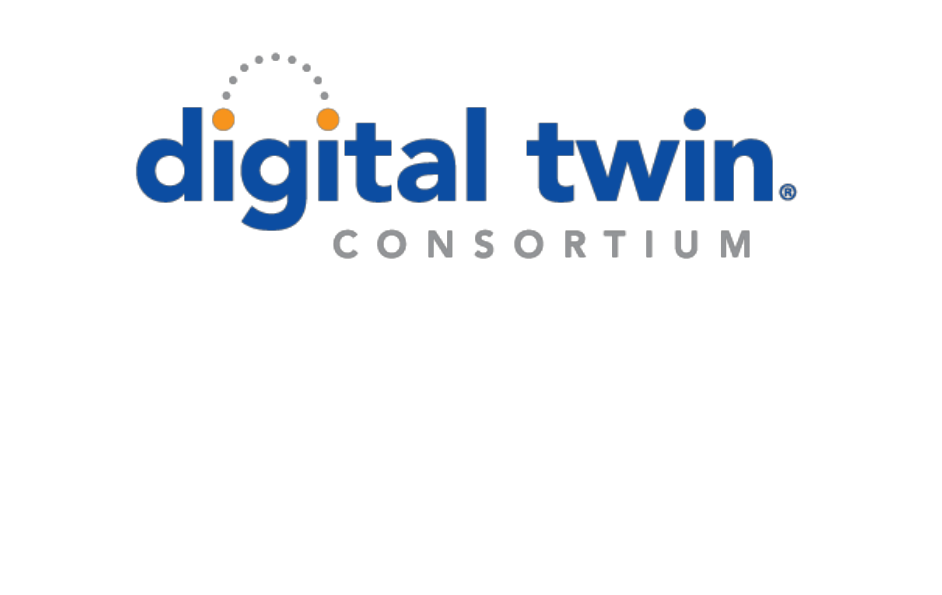
Digital Twin Capabilities Periodic Table
A Digital Twin Consortium User Guide
2022-03-28
Author
Pieter van Schalkwyk (XMPro)

Digital Twin Capabilities Periodic Table
1
CONTENTS
1 Requirements for the Digital Twin CPT .............................................................................. 3
1.1 Capability vs Technology ...................................................................................................... 3
1.2 Enable Composable Digital Twins ......................................................................................... 3
1.3 Ecosystem vs Single Vendor ................................................................................................. 4
1.4 Fits Across The Digital Twins Lifecycle .................................................................................. 5
2 The Digital Twin CPT .......................................................................................................... 5
2.1 The Digital Twin CPT Categories ........................................................................................... 5
2.2 The Digital Twin CPT Level 1 ................................................................................................. 7
2.3 The Digital Twin CPT Level 2 ................................................................................................. 8
2.4 Capability Deployment Considerations ................................................................................. 8
3 How to Use the Digital Twin CPT ........................................................................................ 9
3.1 Windfarm Use Cases Examples............................................................................................. 9
3.2 Digital Twin CPT Workflow Summary ................................................................................. 11
4 Future Work.................................................................................................................... 11
Annex A............................................................................................................................... 12
A.1 Digital Twin CPT Detail Description .................................................................................... 12
Authors & Legal Notice ........................................................................................................ 26
FIGURES
Figure 1-1: Composable Digital Twin Reference Model for discrete and system of systems digital twins. . 4
Figure 1-2: Capabilities during the digital twin and digital thread lifecycle. ................................................. 5
Figure 2-1: Digital twin CPT categories in physical and virtual domains. ...................................................... 6
Figure 2-2: Digital twin CPT outline. .............................................................................................................. 7
Figure 2-3: The digital twin CPT. .................................................................................................................... 7
Figure 2-4: Example of Level 2 and Level 3 breakdown. ............................................................................... 8
Figure 3-1:- Example of windfarm digital twin CPT Toolkit in Excel. ............................................................. 9
Figure 3-2: Windfarm Condition Monitoring Maintenance digital twin use case. ...................................... 10
Figure 3-3: Windfarm Energy Prediction Operations digital twin use case. ............................................... 10
Figure 3-4: Digital twins CPT workflow summary. ....................................................................................... 11

Digital Twin Capabilities Periodic Table
2
The Digital Twin Capabilities Periodic Table (CPT for short) is an architecture- and technology-
agnostic requirements-definition framework. It is aimed at organizations that want to design,
develop, deploy and operate digital twins based on use case capability requirements versus the
features of technology solutions.
CPT multidisciplinary teams need to create digital twins requirements specifications in large scale
complex environments. The framework keeps the focus on the capability requirements of
individual use cases, which can then be aggregated to determine the overall capability
requirements, digital twin platforms and other technology solutions that are required to address
the specific business needs.
It follows a periodic table approach with capabilities grouped or “clustered” around common
characteristics. It is easy to interpret in the boardroom when explaining the business case to get
funding for a digital twin project, and on the shopfloor when gathering requirements for a digital
twin application. It provides visual guidance for collaboration, brainstorming and making
capability requirements explicit.
End users that are investigating digital twin technology to address business transformation and
other digitalization needs often ask these three questions:
• What is a digital twin?
• Why should I care?
• How do I get started?
Digital Twin Consortium’s
1
(DTC) definition of a digital twin provides a comprehensive answer to
the first question.
A digital twin is a virtual representation of real-world entities and processes, synchronized at a
specified frequency and fidelity.
• Digital twin systems transform business by accelerating holistic understanding, optimal
decision-making, and effective action.
• Digital twins use real-time and historical data to represent the past and present and
simulate predicted futures.
• Digital twins are motivated by outcomes, tailored to use cases, powered by integration,
built on data, guided by domain knowledge, and implemented in IT/OT systems.
The second question is addressed by the use case reference library being developed by the DTC.
It describes the problem, the impact and the way that a digital twin addresses the specific
business challenge. It highlights the benefits and impact of digital twins in various use cases.
1
https://www.digitaltwinconsortium.org/initiatives/the-definition-of-a-digital-twin.htm

Digital Twin Capabilities Periodic Table
3
This guide assists with the third question on how to get started with digital twins. It provides a
framework for organizations that are just starting on the journey, and it provides a consistent
approach as organizations scale out and increase their digital twin maturity.
1 REQUIREMENTS FOR THE DIGITAL TWIN CPT
1.1 CAPABILITY VS TECHNOLOGY
Capability is the ability to perform certain actions or achieve certain outcomes. The ability to drill
a hole is a simple example of a capability. There are multiple use cases that require holes and
each of them will have unique requirements in terms of the size, the depth or the substance that
is drilled. This may be one of many capabilities required to complete a project where the hole is
part of a successful solution.
The CPT is focused on technology-based capabilities but is agnostic to specific technology or
product solutions. For example, machine learning capability can be provided by several
technology providers, each with different products. During the assessment of vendor capabilities,
the technology solution should fulfill the technological capability requirement of the business use
case.
The approach used in the Digital Twins Capabilities Periodic Table to describe these capabilities
follows a simple structure:
• what it is (capability name),
• what it does (cap-ability description) and
• what it means or purpose (what does it enable).
The CPT is not a reference architecture; it supports multiple architectural approaches. It
highlights the capability building blocks for composable digital twins. The Digital Twin Consortium
reference architecture provides recommended structures and integrations of Internet of Things
(IoT), Information Technology (IT), Operational Technology (OT) and Engineering Technology (ET)
products and services to form a digital twin solution. The CPT supports reference architectures
that end-users may have developed using their own corporate standards, in addition to the DTC
reference architecture.
1.2 ENABLE COMPOSABLE DIGITAL TWINS
Composable Digital Twins (CDT) is an application development approach for digital twins that is
based on the composable enterprise architectural pattern. Composable applications, such as
CDTs, focus on faster time to value, service-based orchestration and reusing packaged business
capabilities to develop and adapt applications as business requirements evolve.
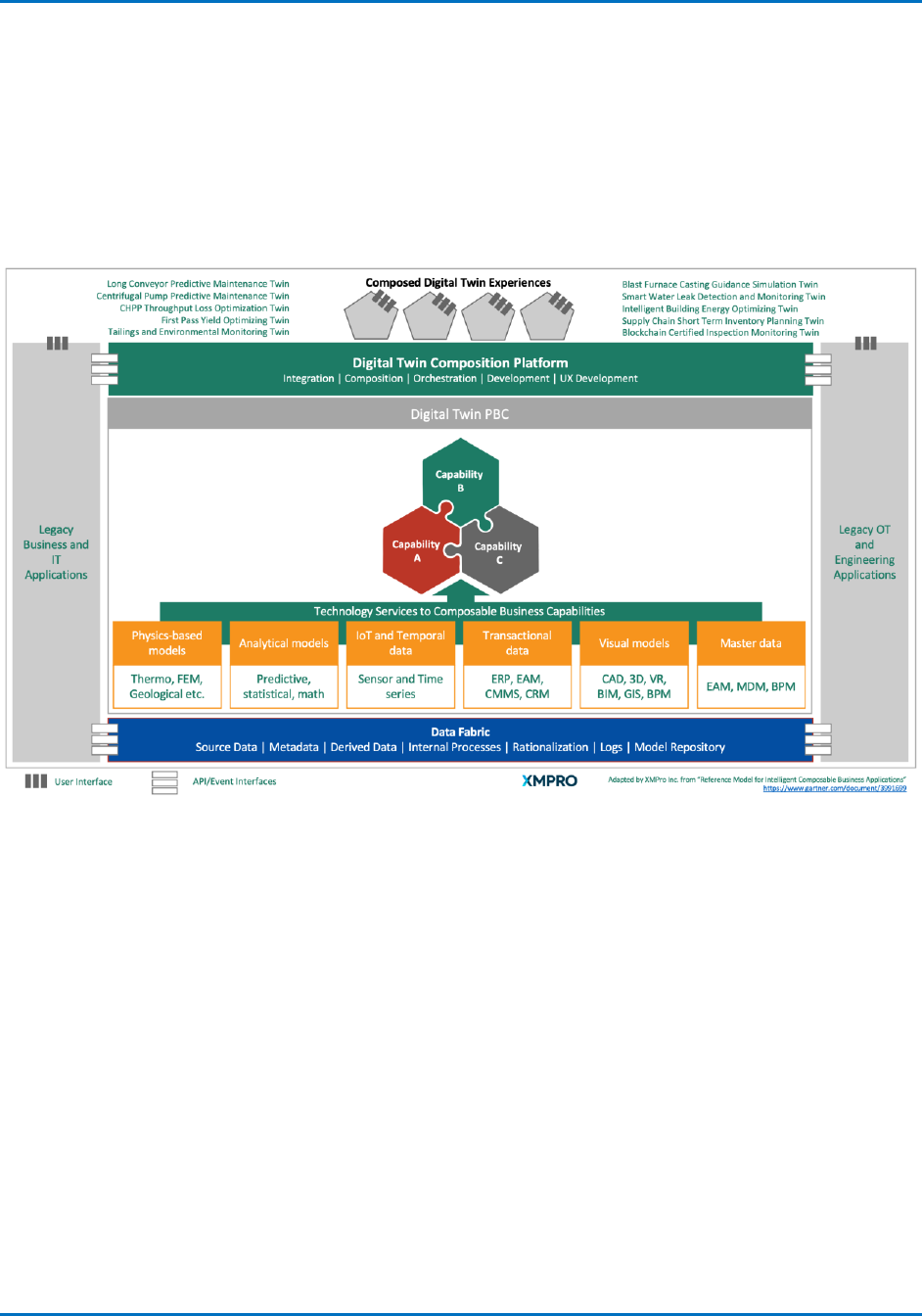
Digital Twin Capabilities Periodic Table
4
Packaged Business Capabilities (PBC) are modular combinations of technical capabilities that are
presented as bundled services. These PBCs are orchestrated together through an application
composition platform to deliver digital twin applications for specific use cases.
The CPT provides a consistent framework to identify the capabilities that can be grouped
together to create these PBCs. Figure 1-1shows a composable Digital Twin reference model that
outlines the different data types and data sources that are leveraged by PBCs to create reusable and agile
Digital Twin compositions.
Figure 1-1: Composable Digital Twin Reference Model for discrete and system of systems digital twins.
A key characteristic of a composable digital twin is that it is typically a combination of capabilities
from multiple technology vendors. Composite or system-of-systems digital twins are based on an
ecosystem of capabilities rather than a single vendor.
1.3 ECOSYSTEM VS SINGLE VENDOR
The smorgasbord of capabilities that are all captured in the CPT are beyond the scope of any
single vendor. It requires an ecosystem of interoperable technical capabilities to address large
scale, complex digital twin use cases. The CPT provides a common framework for multiple
vendors to identify and present key capabilities that they provide for a digital twin solution.
This common framework is a major benefit of the CPT for an end user organization that is
clarifying requirements for a digital twin. It removes the focus from vendor-specific technologies
and places it on the key capabilities that are required to deliver a digital twin solution successfully.
It is useful in analyzing a vendor solution to see if it is complete. It provides the opportunity to
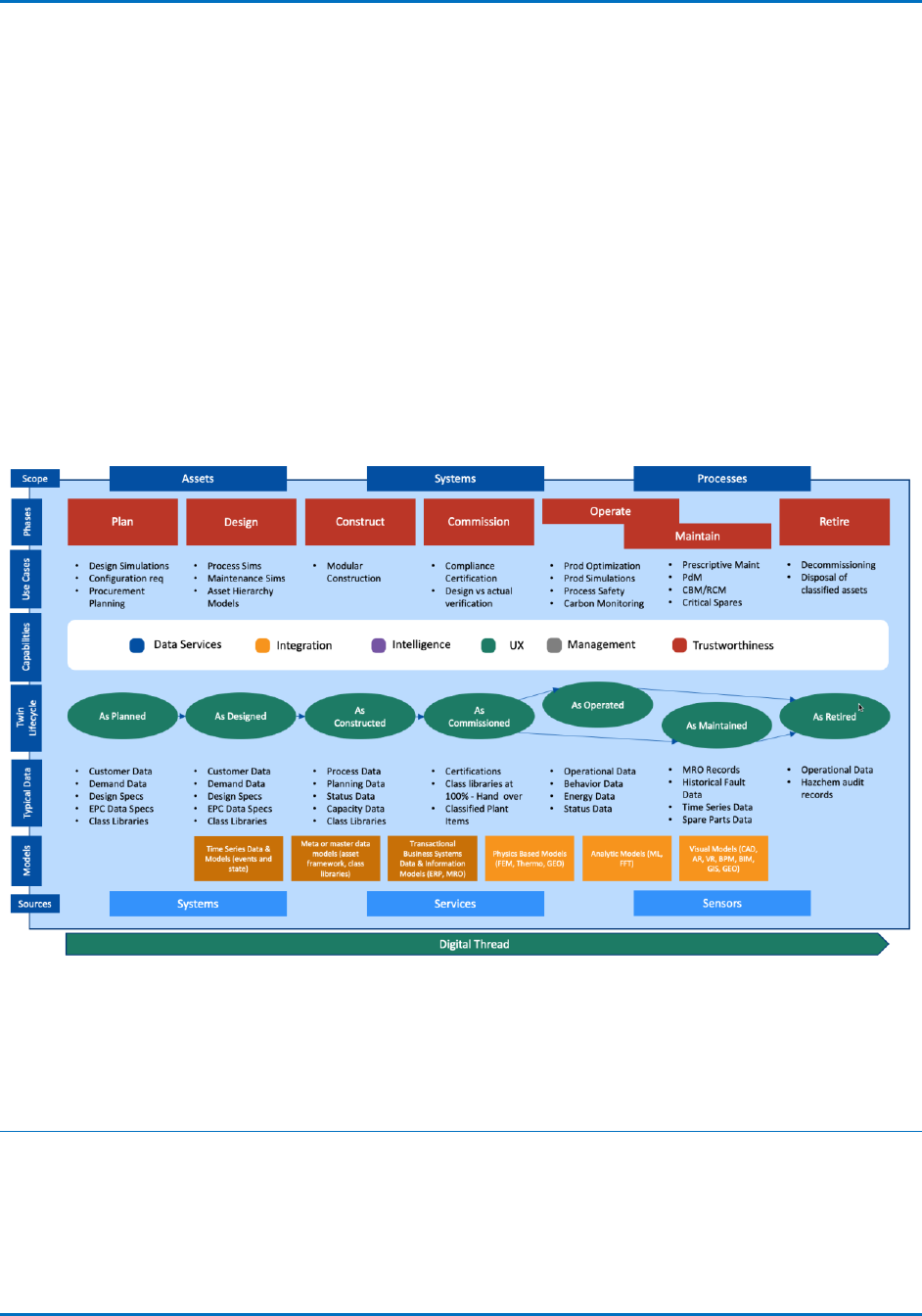
Digital Twin Capabilities Periodic Table
5
light up the capabilities in the requirements and then overlay the capabilities in the solution to
see how well they align.
1.4 FITS ACROSS THE DIGITAL TWINS LIFECYCLE
The CPT is applicable across the full lifecycle of the digital twin. The capabilities may differ during
the different phases but identifying the key capabilities for each phase remains the same
throughout the lifecycle.
Some capabilities may transfer between lifecycle phases, others may become obsolete, and
others may be added. Capabilities during the design and construction phase may not all transfer
to the operations and maintenance phase of an entity like a production plant. This facilitates the
development of the digital thread as it transitions through the different lifecycle phases. As shown
in Figure 1-2,, the digital twin supports the digital thread through these capabilities. The digital twin
Capabilities Periodic table can also be used to identify capabilities for the digital thread.
Figure 1-2: Capabilities during the digital twin and digital thread lifecycle.
The CPT provides a consistent approach for increasing capability maturity at both project and
organizational levels throughout full product life cycles.
2 THE DIGITAL TWIN CPT
2.1 THE DIGITAL TWIN CPT CATEGORIES
The CPT is organized into six logical groupings, matching capabilities that have similar
characteristics and application. Figure 2-1 provides context to the different categories that reflect
both the digital and physical twins.
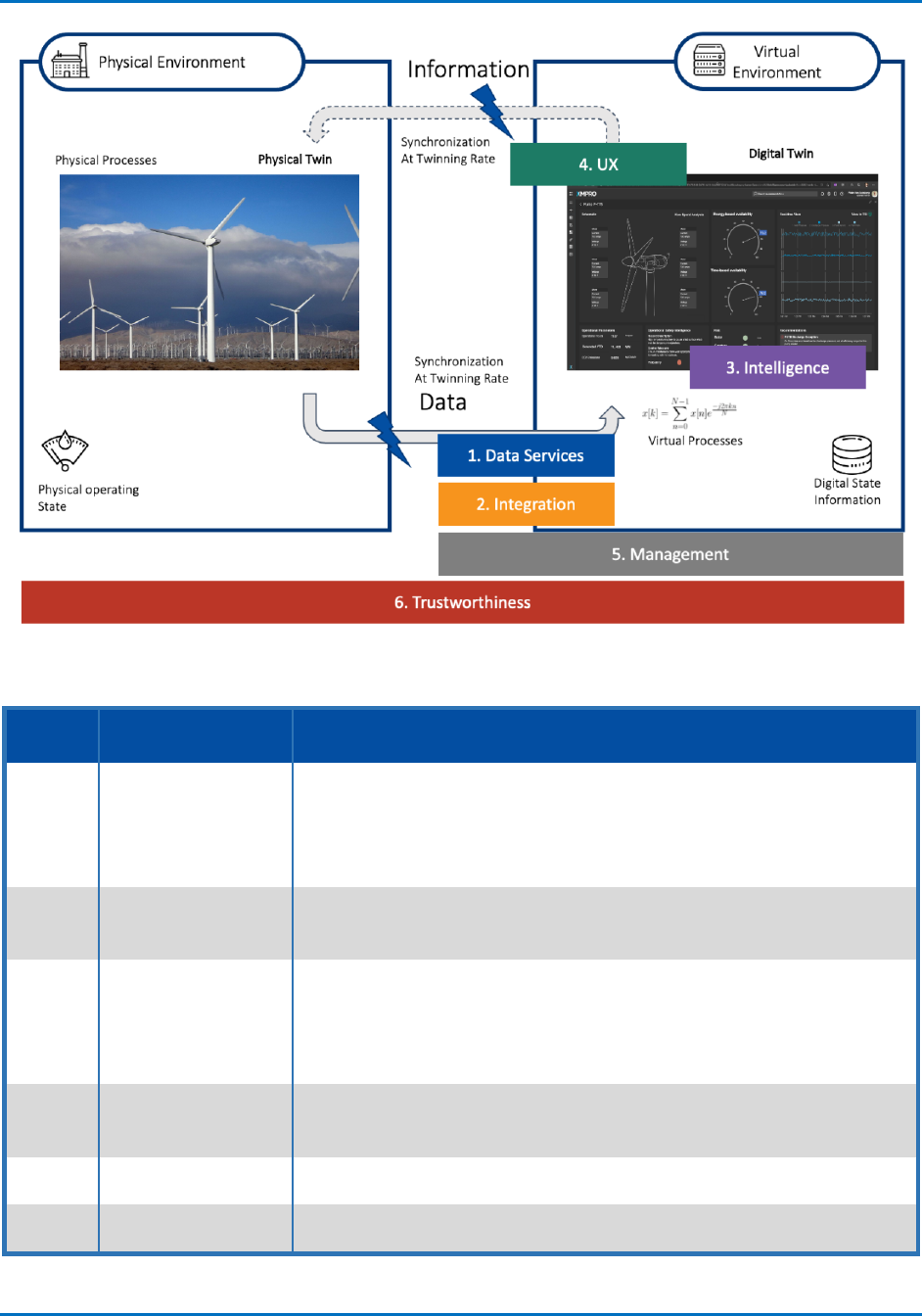
Digital Twin Capabilities Periodic Table
6
Figure 2-1: Digital twin CPT categories in physical and virtual domains.
Table 2-1 summarizes the category names and the category descriptions for the CPT.
No
Category Name
Category Description
1
Data Services
Enables data access, ingestion and data management across the platform
from the edge to the data center. It establishes the physical to virtual
connection and receives data directly from equipment sensors or control
systems, performs localized processing and distributes to other tiers.
2
Integration
Enables data access to existing internal and external enterprise systems and
applications. Enables communication across different digital twins.
3
Intelligence
Provides an environment for the development and deployment of industrial
digital twin solutions. It provides the services for data integration, basic and
advanced analytics, AI, orchestration and other digital twin process
capabilities.
4
UX
Provides the user with the ability to interact with digital twins and visualize
its data.
5
Management
System and ecosystem management capabilities.
6
Trustworthiness
Security, privacy, safety, reliability and resilience capabilities.
Table 2-1: Digital twins CPT category descriptions.
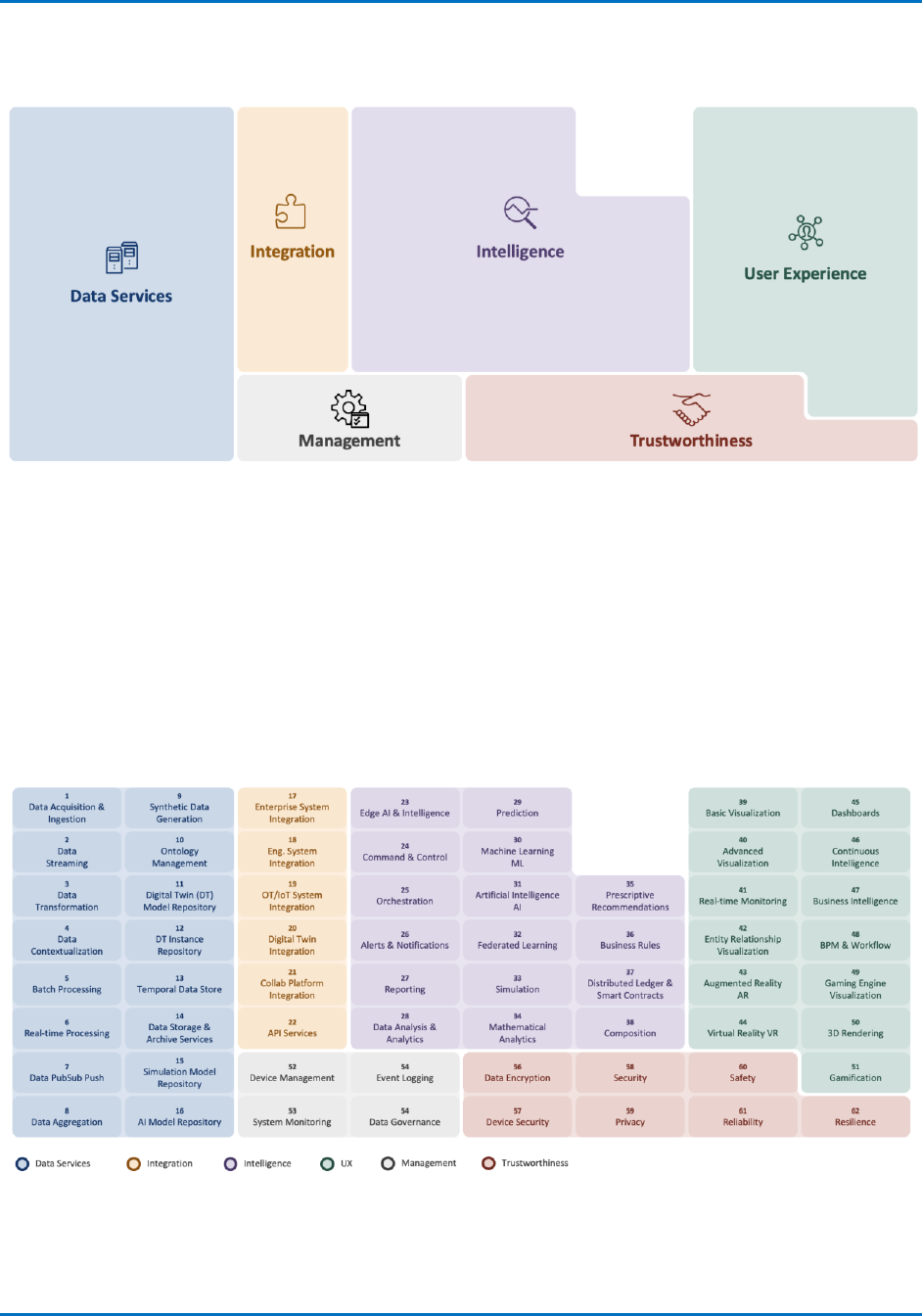
Digital Twin Capabilities Periodic Table
7
The six categories are used in the visual representation of the CPT and are represented in Figure
2-2.
Figure 2-2: Digital twin CPT outline.
This outline provides the container for each of the 60 level 1 capabilities of the CPT.
2.2 THE DIGITAL TWIN CPT LEVEL 1
Level 1 represents the high level capabilities that are grouped based on the categories in Figure
2-1 and the outline presented in Figure 2-2.
Figure 2-3 provides an easy-to-use framework to describe the key capabilities required for digital
twin use cases.
Figure 2-3: The digital twin CPT.
Each of these capabilities may be decomposed into level 2 sub-capabilities to provide more
granular elements if the Digital Twin use case requires clarification.
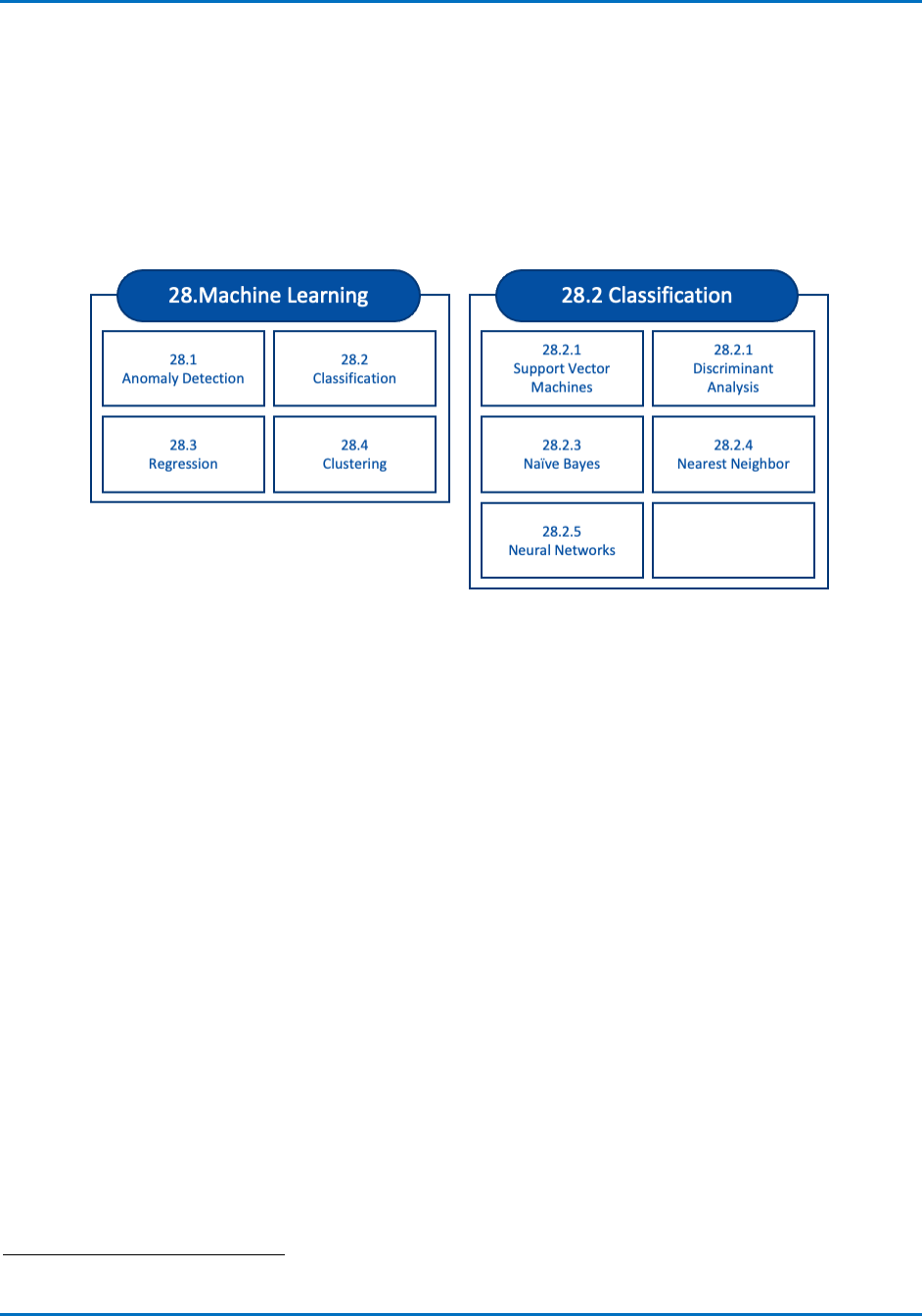
Digital Twin Capabilities Periodic Table
8
2.3 THE DIGITAL TWIN CPT LEVEL 2
Future versions of the CPT may provide specific level 2 capabilities, but in the short term the level
2 capability requirements are defined case-by-case.
The machine learning capability may, for example, be decomposed into specific sub-capabilities.
In certain instances, it may require a third-level breakdown to describe the specific capability that
will address the needs of a specific digital twin use case.
Figure 2-4: Example of Level 2 and Level 3 breakdown.
This is still at the capability level and not technology. Each of the capabilities defined at level 3
for machine learning classification can be achieved with multiple different technologies. This
includes Python on Jupyter Notebooks, Azure Machine Learning, AWS Machine Learning and
Google Cloud Platform, to name a few typical machine learning technology platforms.
2.4 CAPABILITY DEPLOYMENT CONSIDERATIONS
The requirements of a specific use case will determine the deployment environment for the
different capabilities that address the use case.
Some use cases may require the digital twin capabilities at the IoT edge, while others may require
processing in the data center, and in some instances hybrid deployment models may be needed.
The digital twin capability specification must consider the various deployment requirements. The
Industry IoT Consortium (IIC) provides technical guidance on the characteristics of distributed
computing in the Industrial Internet Vocabulary Technical Report.
2
The accompanying Excel CPT Toolkit provides identifying the required deployment environment
for a specific use case. This is demonstrated in the next section on how to use the CPT.
2
https://www.iiconsortium.org/foundational-publications.htm
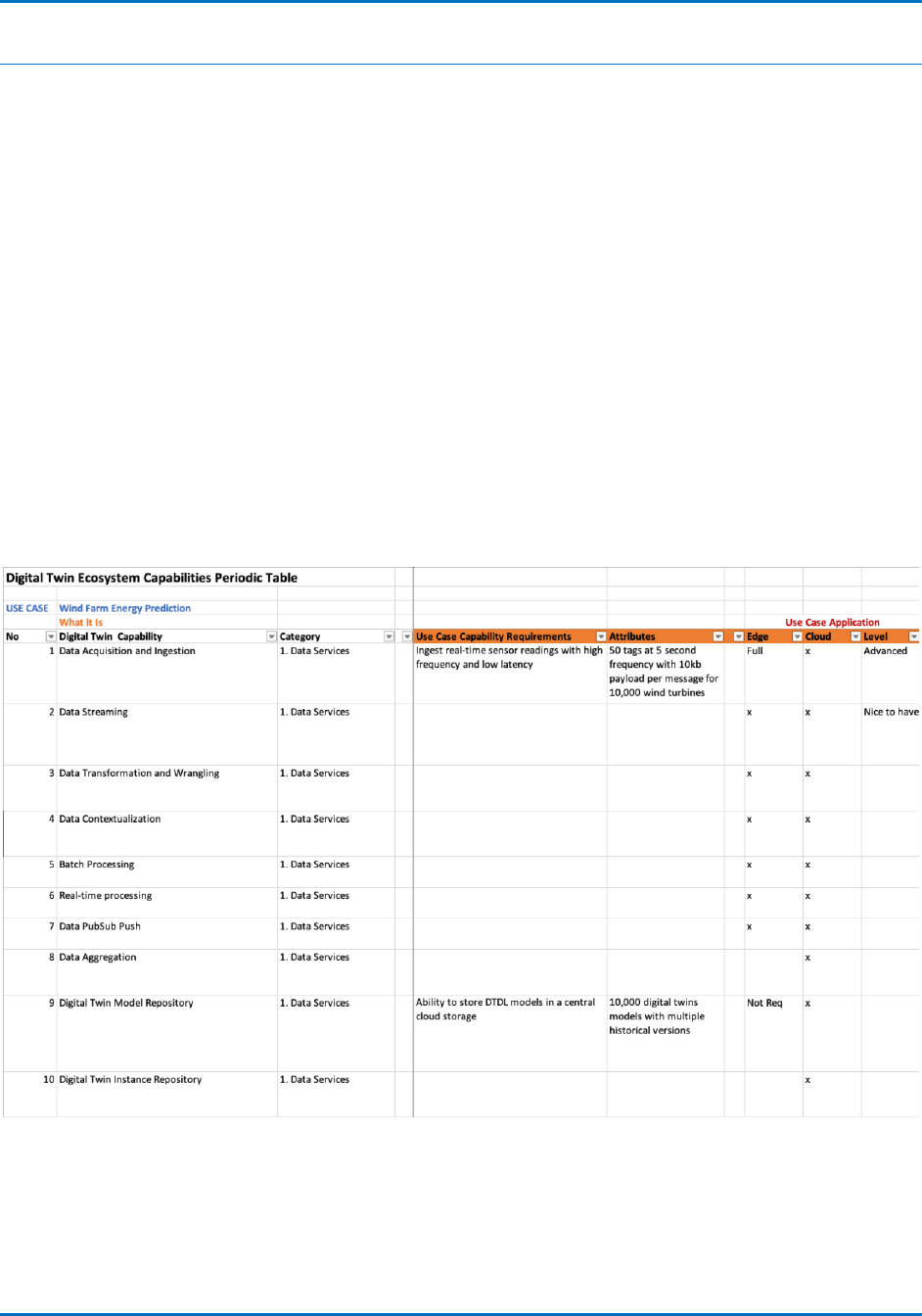
Digital Twin Capabilities Periodic Table
9
3 HOW TO USE THE DIGITAL TWIN CPT
The CPT Toolkit is an Excel template that accompanies this user guide and aims at assisting
requirements gathering and capability specification for a specific digital twin use case.
The Toolkit contains the template periodic table number, capability description, ability
requirements and purpose. The ability and purpose descriptions for each capability may be
edited at an organizational level, but we suggest you use this as the template. The specific use
case capability requirements, attributes and use case application environment is then completed
for each use case.
This is demonstrated by the following two use case examples for a windfarm digital twin.
3.1 WINDFARM USE CASES EXAMPLES
Figure 3-1 shows an example of an energy prediction digital twin in a windfarm. The first few
columns present the static information from the CPT and the columns marked in orange on the
right represent the specific requirements of this use case. This is for illustrative purposes and will
vary on the specific application of the digital twin for the end user.
Figure 3-1:- Example of windfarm digital twin CPT Toolkit in Excel.
In this example, the data acquisition and ingestion capability requirement are for real time sensor
readings with high frequency and low latency. The specific requirement is 50 tags at a five-second
frequency with a 10-kilobyte payload per message, for 10 ,000 wind turbines.
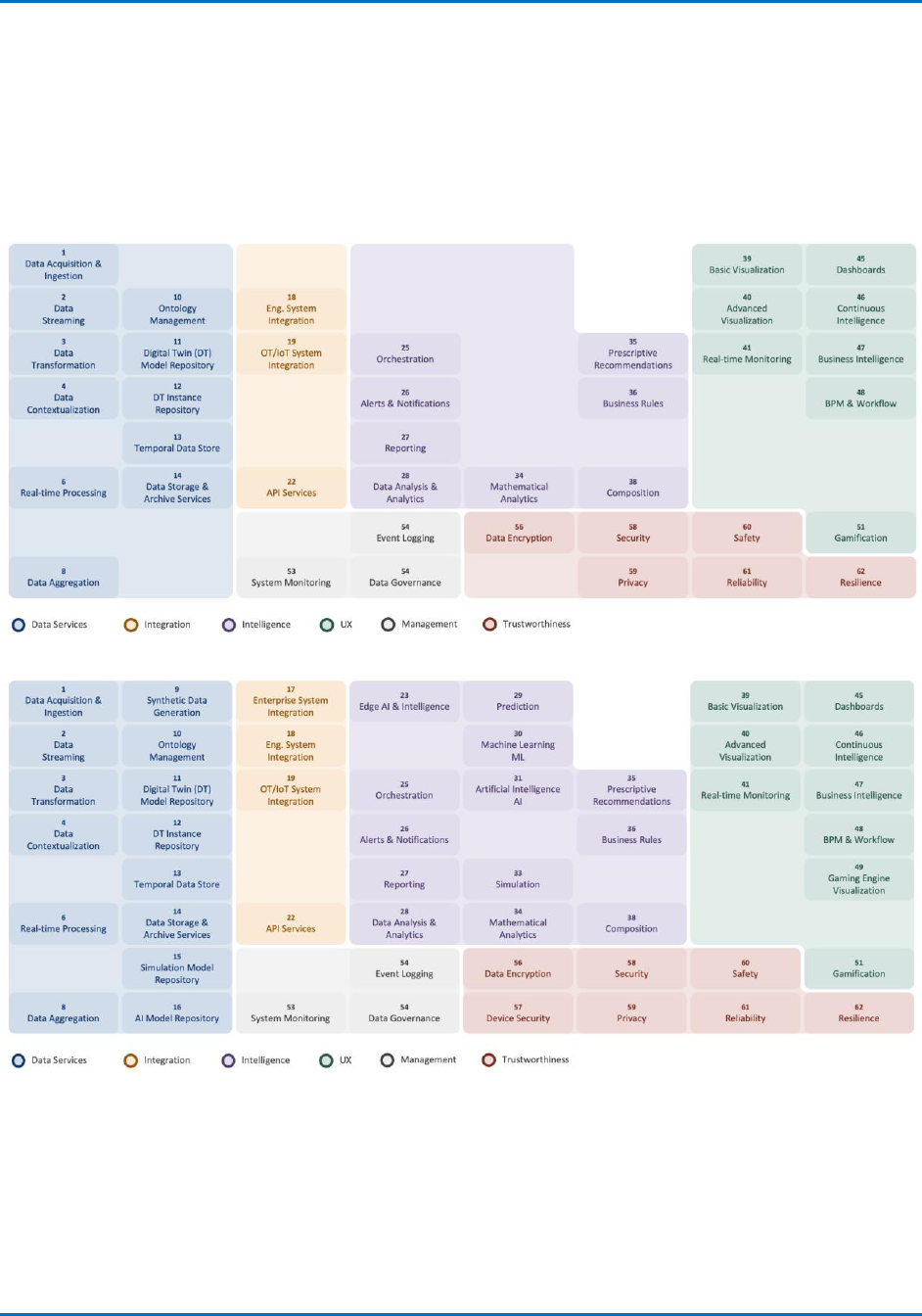
Digital Twin Capabilities Periodic Table
10
It also states that this capability is needed at the edge with potential use in a data center
environment as well. End users can further choose to provide a capability level description such
as basic and advanced. Each organization can create a definition for each of the levels that is
suited to the capability maturity management in the organization.
Different use cases will have different CPT representations, and this is illustrated with two simple
windfarm examples in Figure 3-2 and Figure 3-3.
Figure 3-2: Windfarm Condition Monitoring Maintenance digital twin use case.
Figure 3-3: Windfarm Energy Prediction Operations digital twin use case.
The two periodic tables clearly show overlapping capabilities as well as unique requirements that
are only applicable for a specific application.
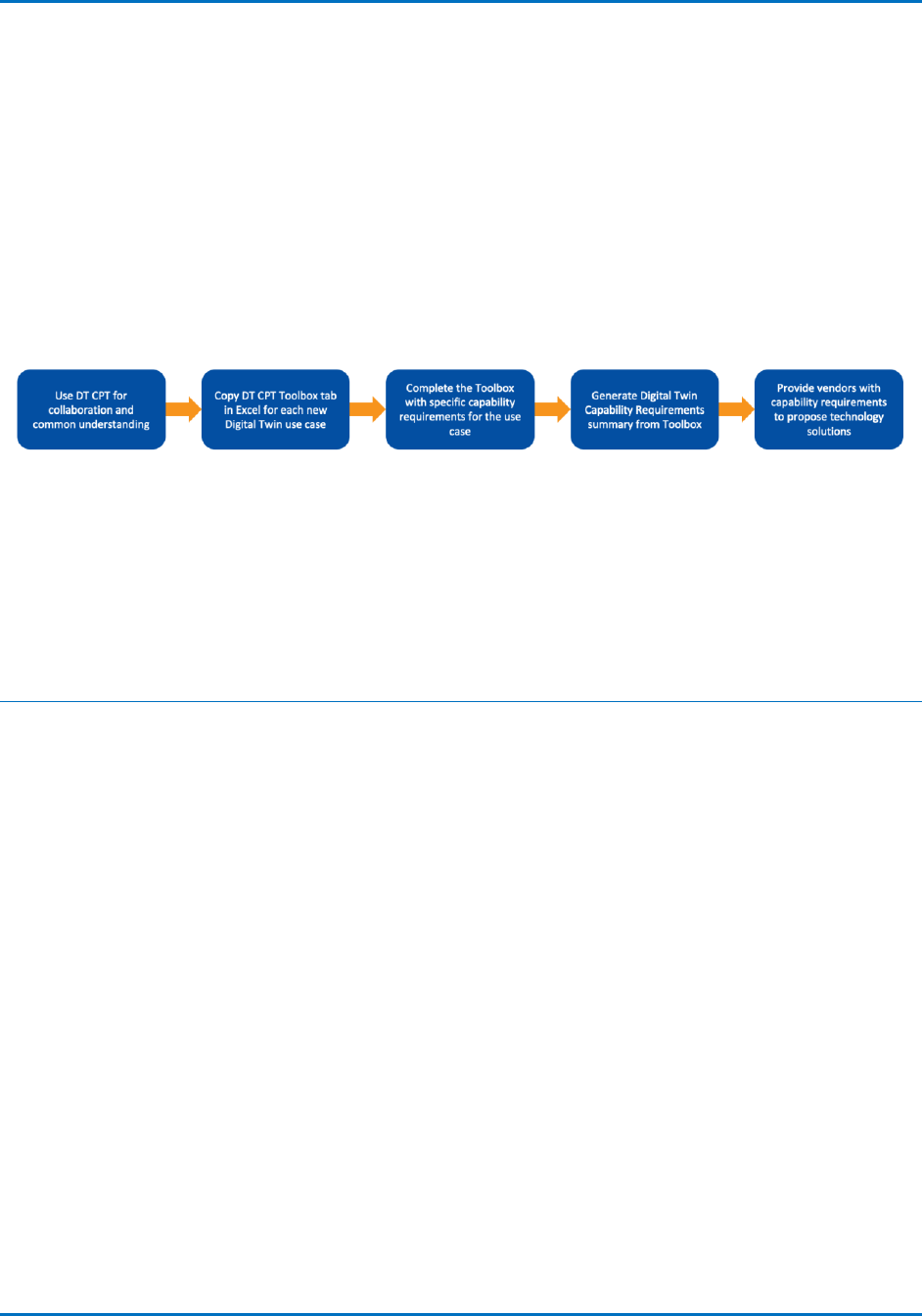
Digital Twin Capabilities Periodic Table
11
3.2 DIGITAL TWIN CPT WORKFLOW SUMMARY
The CPT provides an overall workflow process together and communicates requirements from
internal stakeholders as well as outside stakeholders such as technology solution providers.
Figure 3-4 outlines the suggested workflow, starting with using the periodic table, in
collaboration meetings and presentations to familiarize stakeholders with all the potential
capabilities that can be used in composing digital twins. The single page CPT image is at the right
level for executive presentations. It demonstrates the specific requirements, provides clarity of
business cases and can be used to show estimates for funding requirements to executives and
technical managers, as in the windfarm example.
Figure 3-4: Digital twins CPT workflow summary.
The output of the Toolkit describes all the capability requirements to successfully deliver a Digital
Twin use case. This can be provided to digital twin technology solution providers to propose
products and services, either in isolation, or as part of a broader ecosystem. Vendor solutions
can be ranked and scored against the Digital Twins CPT Toolkit.
4 FUTURE WORK
This user guide introduces a capability-based approach to composing digital twins. Future work
will include level 2 descriptions for each of the capability elements in the Digital Twins CPT, and
potentially a capability maturity model with an index that organizations can use to score progress
towards more mature digital twins.
Other future work may include alignment with other DTC initiatives, including business maturity
frameworks, interoperability models and reference architectures.

Digital Twin Capabilities Periodic Table
12
Annex A
This annex describes the elements in the CPT.
A.1 DIGITAL TWIN CPT DETAIL DESCRIPTION
What it Is
What it Does
What it Means
No
Digital Twin Capability
Category
Ability
Purpose
1
Data Acquisition &
Ingestion
1. Data Services
The ability to configure and acquire
data from different data sources
including control system, historians,
IoT sensors, smart devices,
engineering system, enterprise
systems, etc.
The purpose is to acquire data from
the physical world, engineering
technology systems, and information
technology systems to support
subsequent processing and insight
generation.
2
Data Streaming
1. Data Services
The ability to transfer of large
volumes of data continuously and
incrementally between a source and a
destination without having to access
all data at the same time.
The purpose is to acquire fast
continuous packets of information
that are changing at high speed to be
able to get near real-time insights.
3
Data Transformation &
Wrangling
1. Data Services
The ability to convert data types and
properties through cleaning,
structuring and enriching raw data to
make if suitable for further processing
and analytics.
The purpose is to make data useable
in digital twins.

Digital Twin Capabilities Periodic Table
13
4
Data Contextualization
1. Data Services
The ability to add language or
metadata to enrich real time or
transactional data.
The purpose is to combine data from
different sources (such as real-time
data and slower-changing contextual
data) to make it suitable for
subsequent processing by the digital
twin.
5
Batch Processing
1. Data Services
The ability to execute against
previously collected data in bulk form.
The purpose is to provide is an
efficient way of processing high
volumes of data in batches or groups.
6
Real-time Processing
1. Data Services
The ability to manage and act on the
captured data with minimal latency.
The purpose is to support immediate
insights from the data.
7
Data PubSub Push
1. Data Services
The ability to package filtered data to
different services based on a
publish/subscribe model.
The purpose is to provide information
to subscribed digital twin consumers.
8
Data Aggregation
1. Data Services
The ability to gather raw data and
express in a summary form.
The purpose is to gather data from
multiple sources with the intent of
combining these data sources into a
summary for data analysis.
9
Synthetic Data
Generation
1. Data Services
The ability to generate synthetic data
based on patterns and rules in
existing sources.
The purpose is to create
representative synthetic data that can
used by the digital twin to train and
score predictive models.
10
Ontology Management
1. Data Services
The ability to manage knowledge
graphs and ontologies.
The purpose is to enable a digital twin
to interpret data directly from
knowledge graphs and ontologies.

Digital Twin Capabilities Periodic Table
14
11
Digital Twin Model
Repository
1. Data Services
The ability to store, manage and
retrieve the metadata that describe
the digital twin model. The model can
include formal data names,
comprehensive data definitions,
proper data structures and precise
data integrity rules.
The purpose is to register and manage
a portfolio of digital twin models in a
central repository to improve
configuration management and
model governance.
12
Digital Twin Instance
Repository
1. Data Services
The ability to store, manage and
retrieve digital twin instance data that
conforms to the requirements of the
digital twin model.
The purpose is to store, manage and
retrieve digital twin instance state
data.
13
Temporal (Time Series)
Data Store
1. Data Services
The ability to store, organize and
retrieve data relating to time
instances through temporal data
types, and store information relating
to past, present and potentially future
time.
The purpose is to store, manage and
retrieve temporal (timeseries) data.
14
Data Storage & Archive
Services
1. Data Services
The ability to store, organize and
retrieve data based on how frequently
it will be accessed and how long it will
be retained.
The purpose is to reduce the cost and
effort of managing digital twin data by
using hot, cold and archival data
services
15
Simulation Model
Repository
1. Data Services
The ability to store, manage and
retrieve the algorithmic codebase,
business rules and metadata that
describe a simulation model.
The purpose is to register and manage
a portfolio of simulation models in a
central repository to improve
configuration management and
model governance.

Digital Twin Capabilities Periodic Table
15
16
AI Model Repository
1. Data Services
The ability to store, manage, search
and retrieve the algorithmic codebase
that describe an artificial intelligence
(AI) model or machine learning (ML)
model.
The purpose is to register and manage
a portfolio of AI and machine learning
models in a central repository to
improve configuration management
and model governance.
17
Enterprise System
Integration
2. Integration
The ability to integrate the digital twin
with existing enterprise such as ERP,
EAM, CRM and CMMS.
The purpose is to integrate business
applications, such as ERP, to enable
data to flow between digital twin
systems with ease.
18
Engineering Systems
Integration
2. Integration
The ability to integrate the digital twin
with existing engineering systems
such as CAD, CAM, BIM and
Historians.
The purpose is to integrate business
applications, such as CAD, to enable
data to flow between digital twin
systems with ease.
19
OT/IoT System
Integration
2. Integration
The ability to integrate directly with
control systems and IOT
devices/sensors and SCADA.
The purpose is to integrate business
applications, such as SCADA, to
enable data to flow between digital
twin systems with ease.
20
Digital Twin Integration
2. Integration
The ability to integrate or access
information from existing digital twin
instances.
The purpose is to integrate digital
twin applications with one another to
enable interoperable digital twins.
21
Collaboration Platform
Integration
2. Integration
The ability for the digital twin to
interface with platforms like Yammer,
Jabber, Teams and Slack.
The purpose is to integrate
collaboration platforms to provide
digital twin users with a
conversational user interface.

Digital Twin Capabilities Periodic Table
16
22
API Services
2. Integration
The ability for the digital twin to
publish APIs to external, partner and
internal developers to access data and
services.
The purpose is to simplify digital twin
development by allowing data to
integrate data with the endpoint.
23
Edge AI & Intelligence
3. Intelligence
The ability to make decisions at the
device level based on real -time data,
distribution, and federation of
analytics at the edge instead of
transporting the data to the cloud to
perform analytics.
The purpose is to make real-time
decisions at the edge.
24
Command & Control
3. Intelligence
The ability to execute upon work
instructions without human
interaction. Control would be limited
to IoT devices and non-plant controls.
The purpose is to support future
smart IoT devices with centralized
management.
25
Orchestration
3. Intelligence
The ability to coordinate the
automated configuration,
management and coordination of
systems, applications, digital twins
and services.
The purpose it to manage complex
tasks and workflows between
different systems, applications, digital
twins or systems of digital twins
easily.
26
Alerts & Notification
3. Intelligence
The ability to display and manage
alerts, messages, message queues,
triggers and notifications.
The purpose is to trigger actions that
may require intervention to the
ongoing processes.
27
Reporting
3. Intelligence
The ability to generate configurable
and customizable reports to get
insights into the data.
The purpose is to get insights into the
data that can be useful for various
stakeholders in the system as well as
for regulatory compliance.

Digital Twin Capabilities Periodic Table
17
28
Data Analysis &
Analytics
3. Intelligence
The ability to analyze data through
charts, tables and dashboards; to
fetch data between dates and filter
data based on various criteria. The
analysis of data, typically large sets of
business data, using mathematics,
statistics and software with an
objective to draw conclusions.
The purpose is to understand past
trends from historical data.
29
Prediction
3. Intelligence
The ability to estimate that a specified
event will happen in the future or will
be a consequence of other events.
The purpose is to use historical data,
engineering, and analytical models to
predict events before they occur.
30
Machine Learning (ML)
3. Intelligence
The ability of computer algorithms to
improve a digital twin automatically
through experience. The algorithms
build a mathematical model based on
training data, to make predictions or
decisions without being explicitly
programmed to do so. It is seen as a
subset of artificial intelligence.
The purpose is to enable the digital
twin and digital twin systems to learn
from data, identify patterns and make
decisions with minimal human
intervention.

Digital Twin Capabilities Periodic Table
18
31
Artificial Intelligence
3. Intelligence
The ability for a system to perform
actions and take decisions like
humans. AI would include machine
learning, natural language processing,
knowledge modelling and
representation, reasoning, inferencing
etc. It is based on the capacity of a
computer to perform operations
analogous to learning and decision
making in humans, as by an expert
system, a program for CAD or CAM or
a program for the perception and
recognition of shapes in computer
vision systems.
The purpose is to enable a digital twin
or a digital twin system to take
actions and decisions similar to
humans.
32
Federated Learning
3. Intelligence
The ability to train an algorithm across
multiple decentralized digital twin
edge devices or servers holding local
data samples, without exchanging
their data samples.
The purpose is to enable multiple
actors to build a common, robust
machine learning model without
sharing data, thus addressing critical
issues such as data privacy, data
security, data access rights and access
to heterogeneous data.
33
Simulation
3. Intelligence
The ability to create an approximate
imitation of a process or a system
using past historical information,
physical models, video, audio and
animation. What-if-scenarios.
The purpose is to imitate the behavior
of a physical system in the digital twin
before applying to the physical world.
Training operations and maintenance
teams on simulated digital twins is
another purpose of simulation.

Digital Twin Capabilities Periodic Table
19
34
Mathematical Analytics
(Engineering
Calculations)
3. Intelligence
The ability to perform mathematical
and statistical calculations to enable
physics-based and other
mathematical models.
The purpose is to enable the use of
physics models and mathematics
calculations in digital twin analytics.
35
Prescriptive
Recommendations
3. Intelligence
The ability to create prescriptive
recommendations based on business
rules and AI logic to suggest the best
next actions to take when a pre-
determined event happens.
The purpose is to enable digital twins
to provide guidance based on a
combination of analytics, business
rules and workflow to create actions
and deliver business outcomes.
36
Business Rules
3. Intelligence
The ability to create, manage and use
business rules that influence the
digital twin behavior throughout its
lifecycle.
The purpose is to enable digital twins
to provide and manage business rules
that influence a digital twin’s
behavior.
37
Distributed Ledger &
Smart Contracts
3. Intelligence
The ability to use distributed ledgers
for digital twin applications that
require immutable data for digital
twin instances, transactions and
automation (smart contracts).
The purpose is to enable digital twins
to interact in an automated,
trustworthy and responsible manner
with systems that support smart
contracts and provide a full,
immutable transaction record.
38
Composition
3. Intelligence
The ability to use a modular digital
twin application development
approach to compose and recompose
digital twin services that deliver use
case specific outcomes rapidly.
The purpose is to compose or
recompose digital twins from a set of
packaged, reusable business
capabilities (PBCs) to reduce time to
value, duplication and support citizen
development of digital twins.

Digital Twin Capabilities Periodic Table
20
39
Basic Visualization
4. UX
The ability to visualize data through
simple charts, graphs, simple
dashboards, tables, hierarchical and
basic 3D views of the assets
graphically or parametrically (that is,
through parameters and values).
The purpose is to help people
understand the significance of data by
placing it in a visual context.
40
Advanced Visualization
4. UX
The ability to visualize data through
complex charts and graphs,
dashboards fetching raw and process
data from multiple systems, complex
3D models and animations,
visualizations with overlayed data
from different systems graphically or
parametrically (that is, through
parameters and values).
The purpose is to help people
understand the significance of data by
placing it in a visual context.
41
Real-time Monitoring
4. UX
The ability to present and interact
with continuously updated
information streaming at zero or low
latency.
The purpose is to help make decisions
that are of consequence to real-time.
42
Entity Relationship
Visualization
4. UX
The ability to present digital twin
entities and their hierarchical or
graph-based relationships
interactively.
The purpose is to help business users
navigate and interact with complex
entity (asset) hierarchies in a user-
friendly manner.

Digital Twin Capabilities Periodic Table
21
43
Augmented Reality (AR)
4. UX
The ability to provide an interactive
experience of a real-world
environment where the objects that
reside in the real world are enhanced
by computer-generated perceptual
information such as visual, auditory or
haptic environments.
The purpose is to realize an improved,
immersive and interactive experience.
44
Virtual Reality (VR)
4. UX
The ability to provide a simulated
experience that can be similar to, or
completely different from, the real
world.
The purpose is to realize an improved,
immersive, and interactive
experience.
45
Dashboards
4. UX
The ability to provide a graphical user
interface that provides at-a-glance
views of key performance indicators
relevant to a particular objective or
business process.
The purpose is to enable various
personas in operations, technology,
and business to understand the
current or past state of a system
visually.
46
Continuous Intelligence
4. UX
The ability to analyze data in flight
(signals) to derive insights and actions
in a business user-focused visual
interface.
The purpose is to have various
personas in operations, technology,
and business to make informed real-
time decisions.
47
Business Intelligence
4. UX
The ability to analyze stored data
(records) to derive insights and
actions in a business user focused
visual interface.
The purpose is to have various
personas in operations, technology,
and business to make informed real-
time decisions.
48
Business Process
Management &
Workflow
4. UX
The ability to execute a sequence of
actions as a process flow to achieve
specific business outcomes.
The purpose is to have effective,
repeatable actions that deliver the
business outcomes of the digital twin.

Digital Twin Capabilities Periodic Table
22
49
Gaming Engine
Visualization
4. UX
The ability to create immersive virtual
worlds and interactive experiences
with gaming engine technology.
The purpose it to enable digital twins
in a digital metaverse where users
interact with the digital twin highly
interactively.
50
3D rendering
4. UX
The ability to render 3D visualizations
from point cloud data sets generated
by LiDAR and other scanning
technologies.
The purpose is to interact with large
point cloud and 3D datasets in a user-
friendly manner.
51
Gamification
4. UX
The ability to enable game playing in
digital twin interactions.
The purpose is to facilitate
gamification elements such as points
scoring, badges and competition in
the user experience and interactive
engagement of a digital twin.
52
Device Management
5. Management
The ability to provision and
authenticate, configure, maintain,
monitor and diagnose connected IoT
devices operating as part of digital
twin environment.
The purpose of (IoT) device
management is to provide and
support the spectrum of functional
capabilities of the devices and
sensors.
53
System Monitoring &
Alerting
5. Management
The ability to observe digital twin
systems, applications, and services by
collecting, analyzing and acting on
their health data to maximize their
availability and performance.
The purpose of system monitoring is
to provide and support the whole
spectrum of digital twin systems,
applications and services.

Digital Twin Capabilities Periodic Table
23
54
Logging
5. Management
The ability to record events and
transactions; to access user data and
their transactions to understand and
trace the activities occurring in a
digital twin system.
The purpose of event logging is to
provide records that enable event
activities to be traced within a digital
twin system.
55
Data Governance
5. Management
The ability to manage the availability,
usability, integrity and security of the
data in digital twin systems, based on
internal data standards and policies
that control data usage.
The purpose is to ensure that data is
consistent and trustworthy and
doesn't get misused.
56
Data Encryption
6.Trustworthiness
The ability to convert digital twin data
from a readable format into an
encoded format that can be used to
transfer data securely. It includes the
ability to decrypt the data to read or
process the data once it reaches its
destination.
The purpose of data encryption is to
protect digital data confidentiality as
it is stored in a digital twin system,
accessed and transmitted.
57
Device Security
6.Trustworthiness
The ability to enforce authenticated
and authorized access to IoT device
data through identity management,
role-based access, encryption and
policies.
The purpose is to control access to
device data by having the appropriate
privileges and enforcement
framework for users and programs.

Digital Twin Capabilities Periodic Table
24
58
Security
6.Trustworthiness
The ability to protected digital twins
from unintended or unauthorized
access, change or destruction.
Security concerns equipment, systems
and information, ensuring availability,
integrity and confidentiality of
information.
The purpose is to ensure a digital twin
is protected from unintended or
authorized access, change or
destruction.
59
Privacy
6.Trustworthiness
The ability to enable the rights of
individuals that interact with digital
twins to control or influence what
information related to them may be
collected and stored and by whom
and to whom that information may be
disclosed.
The purpose of privacy is to ensure
the rights of individuals with regards
to data collection, storage and use is
respected and enforced.
60
Safety
6.Trustworthiness
The ability to operate digital twins
without causing unacceptable risk of
physical injury or damage to the
health of people, either directly, or
indirectly as a result of damage to
property or to the environment.
The purpose is to ensure a digital twin
is operating safely without causing an
unacceptable risk to safety.
61
Reliability
6.Trustworthiness
The ability of a digital twin system or
component to perform its required
functions under stated conditions for
a specified period. This includes
expected levels of performance, QoS,
functional availability and accuracy.
The purpose is to ensure a digital twin
is able to operate and maintain an
acceptable level of service as
continuously as possible.

Digital Twin Capabilities Periodic Table
25
62
Resilience
6.Trustworthiness
The ability of a digital twin system or
component to maintain an acceptable
level of service in the face of
disruption. This includes the ability to
recover lost capacity in a timely
manner (using a more-or-less
automated procedure) or to reassign
workloads and functions.
The purpose is to ensure a digital twin
is able to operate and maintain an
acceptable level of service when
disrupted.

Digital Twin Capabilities Periodic Table
26
AUTHORS & LEGAL NOTICE
Copyright © 2022, Digital Twin Consortium®, a program of Object Management Group, Inc.
(“OMG®”). All other trademarks in this document are the properties of their respective owners.
This document is a work product of the Digital Twin Consortium Natural Resources Working
Group, co-chaired by Pieter van Schalkwyk (XMPro), and John Reynolds (Agile Fractal Grid).
Author: The following person contributed substantial written content to this document: Pieter
van Schalkwyk (XMPro)
Contributors: The following persons contributed valuable ideas and feedback that significantly
improved the content and quality of this document: Doug Migliori (CloudBlue), Anto Budiardjo
(Padi Inc), Dr. David McKee (Slingshot Simulations), John Turner (Gafcon), Gavin Green (XMPro)
Technical Editor: Dan Isaacs (DTC) oversaw the process of organizing the contributions of the
above authors and contributors into an integrated document.
